
Ft. Lauderdale (FL) Fire-Rescue (FLFR) recently conducted truck company training with its on-duty ladder crews. The content included rotary rescue saw etiquette, vertical ventilation, and cutting sectional garage doors. In addition to ensuring that all the content was covered, we focused on those little nuances that sometimes are missed in the grand scheme of things. We actively searched for the lessons learned pertaining to ladder skills so that they could be used to further enhance our training program. Some valuable takeaways included the following: crews cutting too deep when rolling rafters, members not letting the saw do the work, and crews not holding the handle of the rotary saw efficiently when making horizontal cuts. These lessons, combined with the experiences, thoughts, and advice from senior crews, enabled us to recognize the strong work from our members and to help the Training Bureau to enhance our training program.
The American fire service prides itself on learning from the lessons of our collective experiences. We see this in various corners of our craft: FireFighterCloseCalls.com, the National Institute for Occupational Safety and Health Fire Fighter Fatality Investigation and Prevention Program, the Wildland Fire Lessons Learned Center, and the International Association of Fire Chiefs firefighternearmiss.com program, for example.
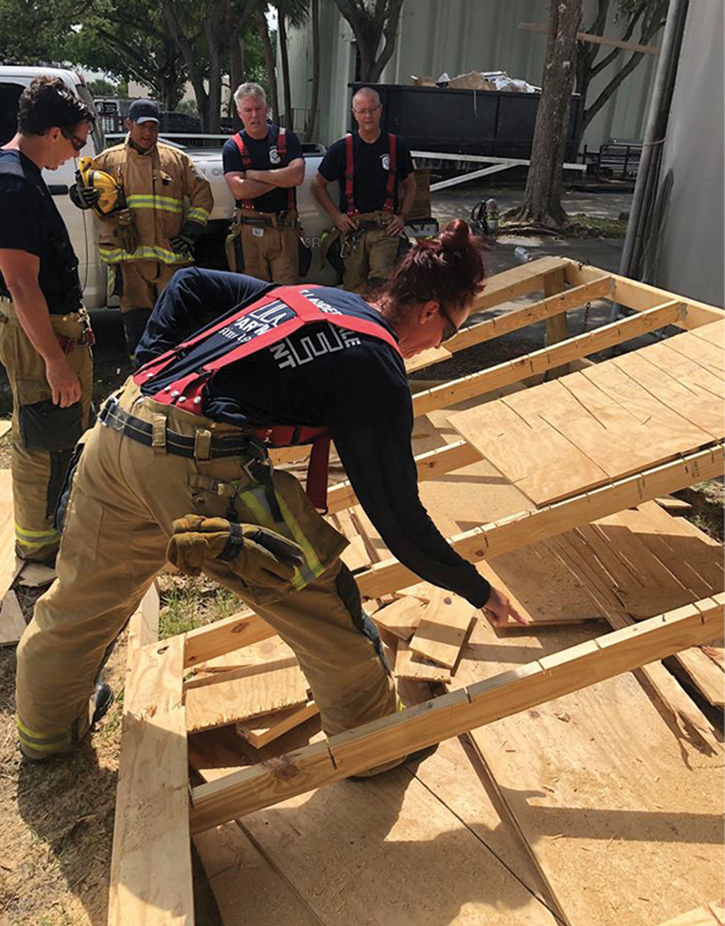
(1) Crews discuss lessons learned while conducting vertical ventilation using saws. (Photos by author.)
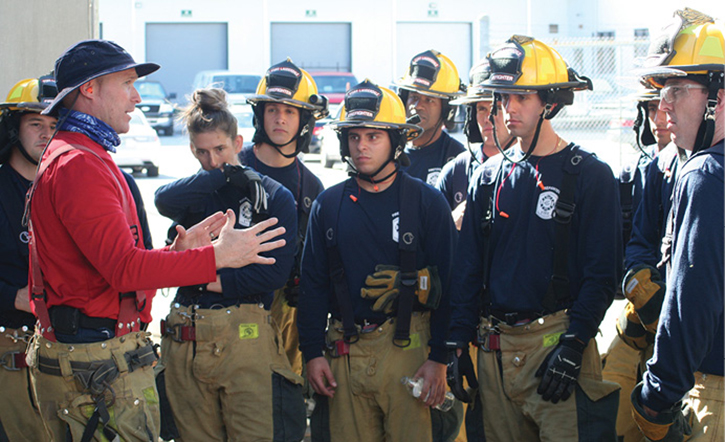
(2) Crews are taught during the firefighter orientation program that mistakes during training are expected and encouraged.
Do you consider the lessons learned during training just oversights or errors? Are they passively ignored, or do you actively look for them during a drill or exercise? What do you do with these lessons? Are they just nice-to-know nuggets and easily tossed aside? Or, do you take this treasure trove of relevant experience and pass it on to your entire organization?
This article highlights the importance of the lessons learned gathered from the training we provide for our crews and makes the case that those lessons learned may be the most important part of the training provided by your organization. The lessons learned from our training are not optional outcomes. They are essential to our situational awareness, to our growth as first responders, and to our survival, and they should be incorporated into every training program we teach to our own.
Experience vs. Training
The greatest experience comes from running calls. This is gospel. We all want to surround ourselves with those who have been there and have done that. We pay homage to our senior members, those who have mitigated emergencies without the technology, studies, personal protective gear, and equipment we have at our disposal today. We want to sit and listen to those who have been at those once-in-a-lifetime runs, the runs to which we believe we will never have the chance to respond. We hang on every word; we close our eyes and try to imagine it as they saw it; and we try our best to squeeze every ounce of knowledge from them when they speak.
A close second to the experiences gained by running calls is a robust, hands-on training program dedicated to sharing knowledge and passing on lessons learned. That program, though, has to have the right culture to cultivate these lessons.
Training Culture
There are organizations outside the fire service that take lessons learned seriously. NASA has an entire Web site dedicated to its lessons learned (https://llis.nasa.gov). The Project Management Institute (PMI) has a detailed lessons-learned process and houses numerous articles on the topic.1 From the top down, there is a culture of knowledge sharing that permeates the entire organization.
What is your training culture? Does your culture center around training, or does it focus on learning? Take a moment to think about the last hands-on class you had. It could be anything—cardiopulmonary resuscitation, rapid intervention, high-rise, live fire, and so on. Have that class in your mind as you answer these questions:
- Why were you there?
- Did learning take place?
- Was everything you did 100% correct?
- How did the class end? Was there a debrief? Hot-wash? After-action report?
- Did you take a written test and just leave?
- Did the class end with a review of what went well and what could be improved and how all that ties into your job?
Okay, that’s a lot to process. Let me provide an example. In 2018, our Training Bureau ran the entire department through high-rise training at a local fire academy. It was grueling—Monday and Wednesday nights, 1800 hours to 2200 hours, almost each week that year. My team worked their butts off to pull off this miracle. It was needed, though, as we are a city growing vertically at a rapid pace and we recently incorporated new high-rise procedures and gear that a video or a memo could not cover adequately. I attended the drill the first night. Though I remember the content that was covered, more interesting was the unplanned learning that took place: the informal mentoring from senior members; the sharing of stories and previous experiences that training helped them recall; and, most of all, the camaraderie that was created or strengthened. We asked so much from them, and they responded in fine, professional fashion, as is expected from an FLFR firefighter.

(3) Crews combine lessons learned from previous drills with new skills prior to scenario-based training.
There were also areas for improvement (there are always areas where we can improve): crews walking past kinks in hoselines, firefighters unfamiliar with the new high-rise standard operating procedures, radios worn incorrectly, unfamiliarity with elevator keys, and so on. These were the things I watched for—what I wanted our crews to feel and experience. It was, I hate to say, vindicating. The few who gave me that “Really? Training at 6 p.m.?” stare when they got there instantly had no ground to stand on. But, we did not let that feeling of vindication set the tone.
Instead, the message to our crews was that we understood their predicament. We know they are responsible for so much. We understand that call volume has gone up, that our scope of practice has expanded over the years, and that it is difficult to be an expert on all the various tools and equipment in our cache. So, at the end of the drill, we not only went over the hose layouts and the high-rise procedures, but we also spoke on the nuances we saw—those “lessons learned”—during that four-hour drill. There were many, they were fresh, and they were relevant because they came from those who had just got done sweating and climbing and dragging and flowing. They meant something more than if they had been discussed over the kitchen table at shift change.
The training culture has to be one that understands and expects mistakes and complications when training. If a drill goes 100% perfectly, something may be off. We want someone to go low on air and start worrying about having to buddy breathe. We want them to forget their lineman’s pliers and be unable to remove a 14-gauge wire from around their air tank. We want, need, and require lessons learned as part of the training program.
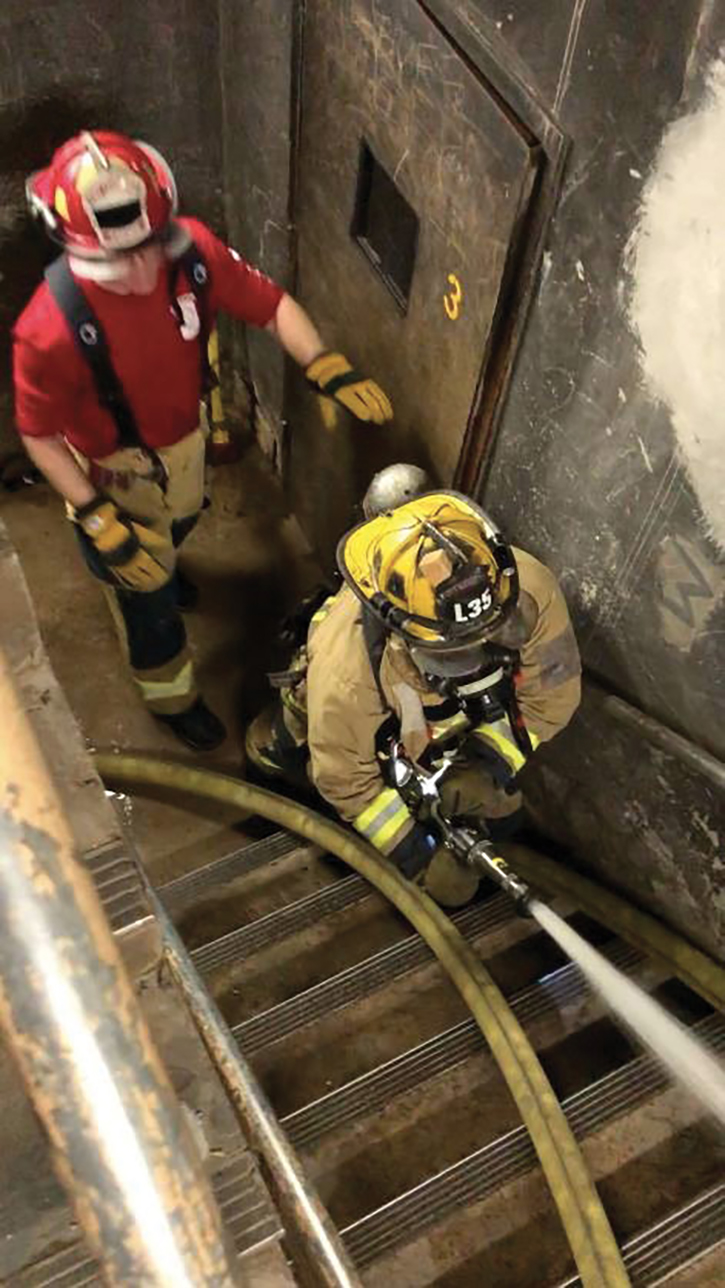
(4) A well-developed hands-on training program brings to the surface areas of improvement beyond what the lesson plan calls for.
This training culture starts from the top. Several months ago, FLFR crews responded to a large two-story, 6,000-square-foot residential structure fire in which the entire bottom floor was a garage used to store multiple exotic cars. There were several challenges: uncommon floorplans, heavy fire load from multiple vehicles involved, narrow one-way streets, multiple sectional and rolling overhead doors, and a pool in the backyard, to name a few. Not only did the assistant chief on that shift want to turn this into a post-incident review for the entire department, but he, his command staff, and various senior members who operated on that scene agreed to be on a video narrating the entire incident. They covered what went well but, more importantly, what could have been improved. My point is, if you have senior respected members of your agency humble enough to admit errors and discuss where things could have gone better in an open forum, who understand a learning culture, then you work with true leaders. That lack of ego or hubris gives permission for everybody else under their command to have open, constructive discussion in which every member can learn.
How to Incorporate Lessons Learned from Training
Quite possibly, the most effective example of developing a tragedy into one of the most comprehensive lessons learned training programs was from the Phoenix (AZ) Fire Department (PFD) after the line-of-duty death of Firefighter Bret Tarver.2 Now, if you’ve never read the 100-page final report on the Southwest Supermarket Fire, stop here and go read it. I mean it. It is brilliant. It stands as a template for all fire rescue departments of the way an after-action report should be structured. The department transformed a tragedy into some of the most powerful knowledge that the fire service has gained. However, you do not have to go as far as Phoenix to incorporate lessons learned into training.
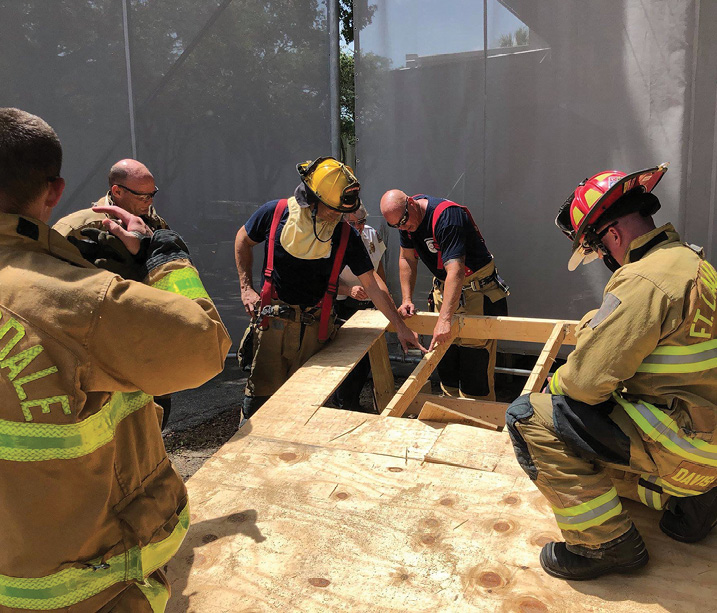
(5) Time should be incorporated into training to review the expected and unexpected lessons learned during training.
Our crews responded to a structure fire several years ago. The windows and doors of the vacant structure were boarded up with sheets of polycarbonate instead of plywood. Crews found the sheets extremely difficult to force conventionally, and the rotary saws with diamond blades did little damage. After consulting with the crews that had been on scene, the Training Bureau met with the manufacturer of the polycarbonate sheets and began researching the product. Conveniently, at the same time, we also found a two-story motel that was scheduled to be demolished. The company that was installing the polycarbonate panels agreed to secure multiple openings on the structure with the sheets, and crews (including those who responded to the fire) were given the chance to try out multiple methods to force entry and cut multiple panels. The lessons learned were used to create a training video that combined all the experiences from an actual incident with the multiple days of training.
Lessons Learned Strengthen a Program
I was the lead lab instructor for a paramedic class through a local college for eight years. At the start of each semester, we had the students read and sign a Statement of Understanding that covered everything from mandatory class times to what to do if you missed a class and how the “megacode” tests (scenario-based medical exams) were structured. Without fail, at the end of each semester, a student would do something or bring something up that landed in a “gray” area. Immediately afterward, the gray area was corrected, and the student received the benefit of the doubt—in other words, the student was not penalized for the lack of attention to detail on our part—and the Statement of Understanding grew stronger. During those eight years (24 semesters), that document grew from a single-page document to a four-page manifesto. Those “lessons learned” created an iron-clad policy that accounted for almost every conceivable scenario that could occur.
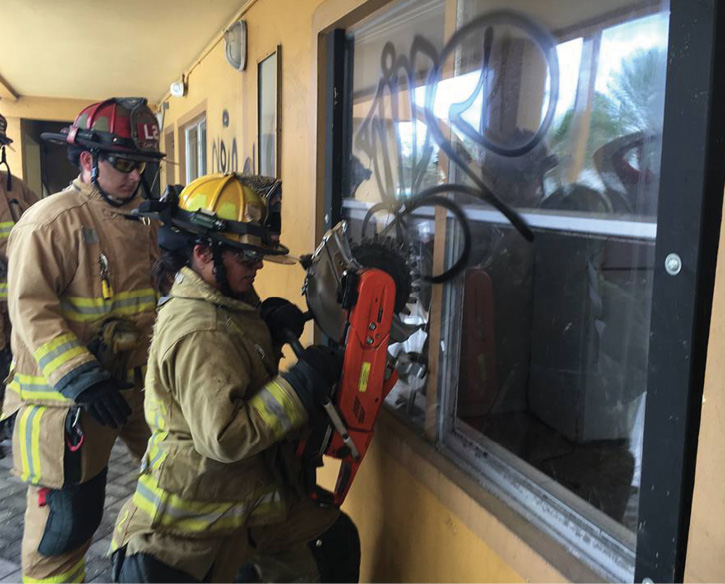
(6) A strong collaboration between the training division and those in the field can take challenges found in the field and transform them into relevant training opportunities.
One semester, a student who had justifiably failed lab challenged the results of his exam and called the school dean directly to complain. I received the call from the dean and immediately drove over with the paperwork the student had signed in hand. The dean slowly and thoroughly reviewed the Statement of Understanding. When she had read the document, she looked up and simply stated, “I’m sorry to have wasted your time.” The student did not pass the class.
Lessons Learned in Data Collection
A huge advantage of a robust training program is the avenue for data collection. Do you think after running more than 400 personnel through months and months of high-rise training that any recommendation that the Training Bureau suggested to the administration wouldn’t be approved? Okay, that may be pushing it, but there’s logic here. We are slaves to data these days. “Data Is King.” Have you heard this?3 Years ago, if I yelled loud enough, I could pretty much get what I wanted (a new piece of equipment, a replacement set of bunker gear, a new computer in my office). The “squeaky wheel” got the oil. Today, I can’t get a new stapler without providing the justification behind the need! Though many of us are getting tired of hearing the word “data,” it is what drives our agencies these days. The information gathered and lessons learned from training are phenomenal ways to justify changes in standard operating procedures and the request to upgrade tools and equipment.
In statistical analysis, the larger the sample size used, the more precise the study. Returning to the PFD example, 1,144 uniformed members of the PFD along with members from 19 surrounding agencies participated in the extensive hands-on portion of the training as a result of the Southwest Supermarket Fire.2 This represents a significantly large population for any type of training. The takeaway here is that if you are going to train large numbers of personnel, collect data and use it.
Actions to Take Now
Among actions you can take now to enhance your training are the following:
- Implement a Lessons Learned series following your training programs.
- Use the aforementioned Web sites to make training content more relevant.
- Communicate clearly to all crews in all classes that you expect mistakes and value lessons learned.
- When conducting training, coordinate with your Research & Development Committee or other data-driven group.
Combined with the proper culture, the lessons learned from a thorough training program bring relevancy, encourage motivation, increase structure, and help elevate the training we provide.
References
1. Rowe, S & Sikes, S. (2006). “Lessons Learned.” Retrieved from https://www.pmi.org/learning/library/lessons-learned-next-level-communicating-7991/.
2. Kreis, S. (2003) “Rapid Intervention Isn’t Rapid.” Retrieved from https://emberly.fireengineering.com/articles/print/volume-156/issue-12/features/rapid-intervention-isnt-rapid.html Phoenix (AZ) Fire Department. (2002). Retrieved from https://cdn.baseplatform.io/files/base/cygnus/fhc/document/2018/07/Bret_Tarver_Phoenix_LODD_Report.5b476dc9241c6.pdf/.
3. Shaw, S. (2017). “10 Things Every New Training Chief Should Know.” Retrieved from https://emberly.fireengineering.com/articles/2017/11/10-things-training-chief.html/.
Stephen F. Shaw Jr. has spent 20 of his 24 years in the fire service with Fort Lauderdale (FL) Fire Rescue and is the former battalion chief of training and special operations. He is an accredited chief training officer and chief fire officer and the former chair of the Training & Education Subcommittee of the Fire Chiefs Association of Broward County. He is an IAFC Hazmat Committee member, a hazmat specialist with FL-TF2, and the vice chair of the South Florida Local Emergency Planning Committee.

